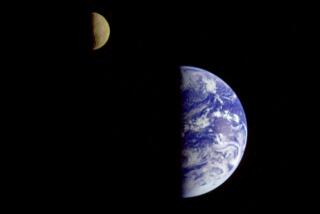Trojan asteroid in Uranus’ orbit: Planets are ‘playing ball’ with it
- Share via
Planetary scientists have detected a Trojan -- an asteroid-like object that shares a planet’s orbit -- circling the sun ahead of Uranus.
The discovery of 2011 QF99, the first of its kind for the ice giant planet, was reported Thursday in the journal Science. According to first author Mike Alexandersen, a doctoral student in astronomy at the University of British Columbia in Vancouver, Canada, it happened almost by accident.
Alexandersen wasn’t looking for a Trojan. Nor was he studying Uranus. He and his colleagues were surveying the transneptunian region of the outer solar system, hoping to see what kinds of orbits the objects there followed. (The transneptunian region is more or less the same thing as the Kuiper Belt. Studying the patterns of the icy orbits in the region helps scientists understand how the solar system formed, 4.5 billion years ago.)
Studying images snapped using the Canada-France-Hawaii telescope during 2011 and 2012, Alexandersen and the team noticed one object that was moving across the field of vision more quickly than the others, an indication that it must have been closer to Earth than the rest.
That wasn’t a surprise, but seeing an object that moved the way 2011 QF99 did was a shocker. The scientists had expected to see objects known as Centaurs, which often move inward into the solar system along quirky paths. But over the course of a year of observations they realized that this space rock was traveling in an orbit very much like that of Uranus, which made it seem more like a Trojan, gravitationally bound to its planet. The mysterious object also oscillated the same way a Trojan would.
“It was, in fact, a Trojan,” said Alexandersen, who added that the team “were certainly not anticipating finding something as cool as this.”
UCLA planetary scientist David Jewitt, who is credited with detecting the first Kuiper Belt object in 1992, said that the transneptunian region is the source of all sorts objects hurtling about the solar system, providing an Armada-like “rain of stuff” cascading inward toward the sun. As they move through the solar system, these objects get caught up in planets’ gravity, either getting hurled away or thrown further inward.
Chunks that float around in the zone of the giant planets are called Centaurs; those that make it into the inner solar system, heating and vaporizing in the sun’s heat, are known as comets. Trojans are the bits that get captured in particular locations in a planet’s orbit where gravity from the sun and gravity from the planet interact to lock them in place.
Some Trojans, around Mars, Neptune and especially Jupiter, are permanently bound to their planets, and have been for billions of years. Others, like 2011 QF99 and Earth’s Trojan 2010 TK7, are only temporarily trapped in their orbits.
“The planets are playing ball with this thing,” Jewitt said, of the newly detected object. “Eventually they’ll lose control of it.”
In their report in Science, Alexandersen and his co-authors described results of a computer simulation that showed that the object was only temporarily bound to Uranus, and that it was likely to drop out of its orbit, becoming a Centaur, within a million years. They also calculated that around 3% of the minor objects in the giant-planet region were likely to be co-orbiting with Uranus or Neptune at any given time. “That was higher than we thought it would be,” Alexandersen said.
The IAU, which names such bodies in the solar system, may decide to give 2011 QF99 a different name eventually. “We may get to send them a suggestion,” Alexandersen said. For now, he will use the remaining few days of scheduled telescope time to continue tracking the Trojan this fall, but “probably won’t study this a lot more,” shifting gears to work on the “planned part of my thesis.”
But 2011 QF99 was “a surprise chapter” that will “certainly make its way” into the final draft, he said.
[For the record, 3:20 p.m. PST Aug. 29: An earlier version of this post called Centaurs “transneptunian objects.” Though Centaurs originate in the transneptunian region of the solar system, they orbit between Jupiter and Neptune.]







